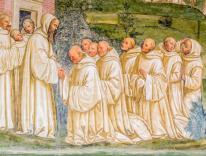
Philosophers who have written about the films of Terrence Malick typically note three biographical facts. First: Malick studied under the philosopher Stanley Cavell at Harvard, from which he graduated summa cum laude in 1965. Harvard’s philosophy department then was intensely “analytic” in orientation—to simplify, it was focused on logic and language—but Cavell’s interests included, as his faculty website states, “the intersection of the analytical tradition (especially the work of [J. L.] Austin and Wittgenstein) with moments of the Continental tradition (for example, Heidegger and Nietzsche),” for whom philosophy was also about the meaning of being and the death of God.
Second: After Harvard, Malick went to Oxford as a Rhodes Scholar, where his adviser was the philosopher Gilbert Ryle, famous in academic circles for his 1949 book The Concept of Mind. Malick wanted to write a thesis on Heidegger and Wittgenstein (and perhaps on Kierkegaard and Nietzsche as well). Ryle purportedly resisted Malick’s request on the grounds that the topic wasn’t “philosophical enough,” which is another way of saying “that’s not what we do here.” (For reflections on academic philosophy in that period, see Daniel Callahan’s essay “Out of Step: God and Me at Harvard and Yale,” October 29, 2012.) Malick returned to the United States after only one year at Oxford.
The third fact: Although he came back to this country without a terminal degree in philosophy, he did not initially abandon his academic ambitions. In 1968 Malick taught a course on Heidegger at MIT, and in 1969 he published a translation—with an introduction and a set of critical notes—of Heidegger’s Vom Wesen des Grundes under the title The Essence of Reasons. Also in 1969, however, Malick entered film school in Los Angeles, apparently having judged himself to be wanting as a teacher. He has not published in philosophy since—unless, of course, his films can be considered contributions to philosophy.
I do not doubt that one could give a thoroughgoing “Heideggerian” interpretation of The Tree of Life, but it is questionable whether such an interpretation would illuminate Malick’s film or only restate its perplexities in terms no less perplexing, if not more so. Consider, instead, some of Malick’s reflections in the introduction to his translation of Heidegger’s text:
Our problems are problems with Heidegger’s language. What gives them their force as problems is that they ask to be solved in and through his language, without further recourse.... If Heidegger resorts to his own peculiar language, it is because ordinary German does not meet his purposes; and it does not because he has new and different purposes. If we cannot educate ourselves to his purposes, then clearly his work will look like nonsense. And yet we should not conclude that it is nonsense merely because we are not sure what is to keep us from the conclusion.
Our problems with The Tree of Life are likewise problems with Malick’s peculiar cinematic language: weird, wordless visions; whispered voice-overs that emerge from deep within the characters, like springs breaking through hardened ground; infinities without and within juxtaposed with the most ordinary of everyday settings; a tissue of quotations and allusions; music that neither merely accompanies, nor simply comments, but suggests new, untold dimensions to what is unfolding before us; and, of course, dinosaurs. Even Sean Penn, who played the character of the grown-up Jack, had trouble construing Malick’s purposes and came close to calling the film nonsense. “Frankly,” he told the French newspaper Le Figaro, “I’m still trying to figure out what I just did there and what I could have added in that context!”
TO FIGURE OUT what Malick’s up to, it might prove helpful to consider why he wanted to study with Ryle at Oxford. In other words, what attracted Malick to Ryle as a teacher? Malick would have known, I imagine, that Ryle published a long review of Heidegger’s Being and Time in 1929, just two years after the book appeared in German and decades before its translation into English. Ryle’s judgment of the book was at once admiring and suspicious: admiring of Heidegger’s “analysis of the root workings of the human soul”; suspicious that the direction in which Heidegger was taking his philosophy was “an advance toward disaster” likely to end either in subjective idealism (dissolving the world into “man-constituted” meanings) or in “a windy mysticism.” Yet Ryle hazards this rather strong “personal opinion…with humility and with reservations since I am well aware how far I have fallen short of understanding this difficult work.” In light of this confession, Malick might have thought that Ryle, like Cavell, would be open to working through Heidegger with him.
Malick surely also would have been familiar with The Concept of Mind. Here Ryle attacks what he calls “the dogma of the Ghost in the Machine”—the “philosophers’ myth,” as he also calls it, that sets mind over and against body as two distinct substances. Ryle’s method in this book is to focus on the mental concepts that we use in our ordinary language: thinking, feeling, knowing, imagining, and the like. His principal claim is that our theorizing about the mind is riddled with what he famously calls category mistakes. It is, for example, a category mistake to think that Oxford University belongs to the same category as the colleges it comprises. Visiting Oxford, one would search in vain for the university if one mistakenly put it in the same category as the colleges with their distinct buildings that everywhere meet the eye. A person is liable to make category mistakes either when he does not know how to use a concept (like that of a British university) or when, though he knows well how to talk sense with a concept like thinking or willing, he does not know how to talk sense about it. This, Ryle argues, is our plight when it comes to our many concepts having to do with the mind.
Why do we make the category mistake of thinking of mind as a substance just like the body, to which the mind is somehow “internal” (even though, unlike the brain, the mind is nonphysical and so does not occupy space)? As he struggles to answer this question, Ryle turns to the seventeenth century—to Galileo and Descartes. But, as Ryle briefly acknowledges, the interpretation of mind in terms derived from the natural world goes back much further in history. Malick would have known this from his own study of Heidegger, who showed that, since the ancient Greeks, what it means to be has been understood in terms of the beings we encounter in the world. Our own mode of being in the world—what Heidegger called our “being-here”—has been overlooked. For this reason, Heidegger believed that Western philosophy needed to be destroyed and replaced, which is the project that his Being and Time begins. Through an analysis of our own mode of being-here, he wanted to pose the question of the meaning of being on a new foundation.
One can perhaps sympathize with Ryle’s reluctance to take on a student enthusiastic about this project. Can “windy mysticism”—or at least Germanic fog—be far away? (Ryle might also have been put off, understandably, by Heidegger’s Nazism in the 1930s.) But it is undeniable that Ryle’s The Concept of Mind pushes in the same direction as Being and Time. For if mind is misconstrued when it’s cast in the same category as body, then while mind-body dualism is wrong (mind is not another substance just like, but over and against, body), it is no less wrong to suppose that mind can be reduced to body—that mental states and processes may be understood in terms of physical states and processes. This is one of the points Thomas Nagel makes in his recent book Mind and Cosmos, the opening line of which claims that the mind-body problem, properly understood, “invades our understanding of the entire cosmos and its history.” (See the symposium “Nagel’s Untimely Idea: Is There More to Nature Than Matter?” May 23, 2013.) Unfortunately, though Ryle too makes this point in The Concept of Mind, he does not develop it at any length. It is an interesting fact that another American student of Ryle’s in the 1960s, the arch-materialist (and arch-atheist) Daniel Dennett, rejected it altogether. Such was the direction, at that time, of Anglo-American philosophy.
As far as I can surmise, what attracted Malick to Ryle was likely twofold: not only his openness to Heidegger’s thought, as evinced in the 1929 review, but, even more, the conjunction of antidualism and antireductionism in Ryle’s own thought, as evinced in The Concept of Mind. I suspect that Malick’s purpose in studying with Ryle was to work out the implications of the fact that mindful life is not that of a ghost within a body, alienated from the “external world.” How, then, should we rethink the world?
Here’s a start. If mind can no longer be excluded from the world, nor accounted for in physical terms, then the world itself cannot be adequately conceived in physical terms on the model of a machine, and this makes the world larger and more luminous. This point has been made beautifully by the novelist and essayist Marilynne Robinson, whose work bears comparison with Malick’s. (See “Thinking Again: What Do We Mean by Mind?” May 7, 2010.) I think it is also presented to the mind’s eye, so to speak, in Malick’s film.
Whatever else there is to say about what Malick is up to in The Tree of Life, I think he is clearly aiming to change the way we see ourselves in relation to the whole, “the entire cosmos and its history.” Filmmaking cannot replace philosophical argumentation. But it can help reorient our thinking by changing the angle or increasing the scope of our vision. I have in mind the film’s astonishing interplay of the galactic, the microscopic, and the quotidian. Against this background, the quotidian remains quotidian while also being charged with mystery and grandeur and, perhaps, the glory of God. It is as if Malick is saying: Behold, seekers of wisdom! Begin your thinking here. The drama of human life unfolds against the background of a cosmos pulsing with the same mysterious stuff that makes up both our conscious and our unconscious minds, our waking experience of the world and our dreams.
Funding for this essay has been provided by a grant from the Henry Luce Foundation.
Please email comments to [email protected] and join the conversation on our Facebook page.
Share
Previous Story
'The Use of Cinema to Do Theology'
Next Story
On the homepage: Minimal wages; Kaveny on ACLU & bishops

